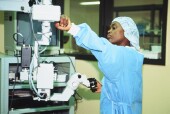'Nanomachine' Releases Anticancer Drugs Inside Cells
In response to light, its pores let loose chemicals targeting disease.
|
E-mail this article
Subscribe to news
Printer friendly version
|

(SOURCE: University of California, Los Angeles, news release, March 31, 2008)
FRIDAY, April 4 (HealthDay News) -- A nanomachine that can kill cancer cells has been developed by researchers at the University of California, Los Angeles.
The "nanoimpeller" collects and stores anti-cancer drugs inside tiny pores and releases the drugs into cancer cells in response to light. It's the first light-powered nanomachine able to operate inside a living cell, said the team from the Nano Machine Center at the California NanoSystems Institute at UCLA.
To create the nanoimpeller, the researchers used mesoporous silica nanoparticles and coated the interiors of the pores with azobenzene, a chemical that changes characteristics when exposed to light.
Laboratory tests were conducted using a number of types of human cancer cells, including colon and pancreatic cancer cells. The nanoimpellers were loaded into the cancer cells in the dark. When light was directed at them, the nanoimpellers released their contents into the cells.
"The achievement here is gaining precise control of the amount of drugs that are released by controlling the light exposure. Controlled release to a specific location is the key issue. And the release is only activated by where the light is shining," Fuyu Tamanoi, a professor of microbiology, immunology and molecular genetics and director of the signal transduction and therapeutics group at UCLA's Jonsson Comprehensive Cancer Center, said in a prepared statement.
He and colleague Jeffrey Zink, a professor of chemistry and biochemistry, said this system "has potential applications for precise drug delivery and might be the next generation for novel platform for the treatment of cancers such as colon and stomach cancer. The fact that one can operate the mechanism by remote control means that one can administer repeated small-dosage releases to achieve greater control of the drug's effect."
The research was published online March 31 in the nanoscience journal Small.
More information
The U.S. Food and Drug Administration has more about nanotechnology products.
Copyright © 2008 ScoutNews, LLC. All rights reserved. 
HealthDayNews articles are derived from various sources and do not reflect federal policy. healthfinder.gov does not endorse opinions, products, or services that may appear in news stories. For more information on health topics in the news, visit the healthfinder.gov health library.